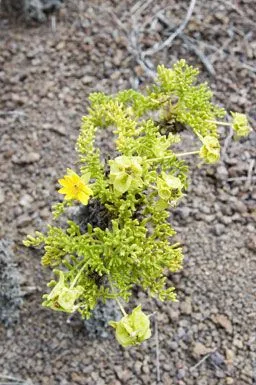
Author: Pursh
Bibliography: Fl. Amer. Sept. 2: 535 (1813)
Year: 1813
Status: accepted
Rank: species
Genus: Erigeron
Vegetable: False
Observations: N. Russian Far East, Subarctic America to W. U.S.A.
Dwarf mountain fleabane, known scientifically as Erigeron compositus, is a perennial herbaceous plant belonging to the Asteraceae family, which is renowned for its diverse and ecologically significant species. Initially chronicled in the botanical literature by Pursh in “Fl. Amer. Sept. 2: 535” in the year 1813, this resilient plant has a wide geographical range encompassing the northern Russian Far East, Subarctic America, and extending to the western regions of the United States.
This species typically thrives in mountainous and subarctic terrains, exhibiting a remarkable adaptability to cold and often harsh conditions. The Dwarf mountain fleabane is characterized by its low-growing habit, often forming tuft-like clusters that allow it to withstand the wind and temperatures common in its native habitats. These plants produce small, daisy-like flowers that exhibit the characteristic composite flower-head structure of the Asteraceae family. The flowers typically feature a central cluster of yellow disc florets surrounded by a fringe of ray florets that can vary in color, though they are most commonly white or pale blue.
Erigeron compositus is not only appreciated for its hardiness and adaptability but also for its role in the ecosystem. It provides nectar and pollen for various pollinators, including bees and butterflies, thus contributing to the maintenance of biodiversity in its native regions. Additionally, its ground-covering growth form helps to stabilize soil and reduce erosion in alpine and subarctic environments.
This plant is also of interest for alpine garden enthusiasts and those interested in native plant gardening, given its attractive floral displays and its ability to grow in poor soils with minimal care. As a result, it contributes to both ecological balance and aesthetic value in cultivated landscapes.
In summary, the Dwarf mountain fleabane, Erigeron compositus, stands out as a plant of both ecological importance and horticultural potential, well-documented since the early 19th century and with a widespread presence across regions characterized by challenging growing conditions.
Eng: cutleaf daisy, dwarf mountain fleabane, cut-leaved fleabane, compound fleabane, cut-leaved daisy, fern-leaved fleabane
Swe: flikbinka
Fra: vergerette à feuilles segmentées, vergerette à feuilles divisées
En: Dwarf mountain fleabane, Cutleaf daisy, FERNLEAF FLEABANE, Cutleaf fleabane, Cut-leaved fleabane, Compound fleabane, Cut-leaved daisy, Fern-leaved fleabane
Ar: أريغارون مركب
Fi: Pikkukallioinen
Fr: Vergerette à feuilles segmentées, Vergerette à feuilles divisées
Fa: اریگرن کمپسیتس
Ru: Мелколепестник сложноцветный
Sv: Flikbinka
Taken Sep 3, 2006 by EOL − Steve Matson (cc-by-nc)
Taken Jul 9, 2021 by David Dodge (cc-by-sa)
Taken May 17, 2020 by Schnelle Scott (cc-by-sa)
Taken May 29, 2021 by Jack Pommer (cc-by-sa)
Taken Jun 20, 2020 by pippa pothead (cc-by-sa)
Taken Apr 25, 2018 by Todd Schnakenberg (cc-by-sa)
Taken May 29, 2021 by Jack Pommer (cc-by-sa)
Taken Oct 8, 2008 by EOL − Gerald and Buff Corsi (cc-by-nc-sa)
Taken Jan 1, 1900 by EOL − Cooper, G.A. (cc-by-nc-sa)
Taken Jan 1, 1900 by EOL − Cooper, G.A. (cc-by-nc-sa)
Taken Nov 25, 2002 by EOL − Gary A. Monroe (cc-by-nc)
Taken Aug 18, 2015 by EOL − Ken-ichi Ueda (cc-by-nc)
Taken Dec 2, 2002 by EOL − Gary A. Monroe (cc-by-nc)
Taken Sep 9, 2009 by EOL − Steve Matson (cc-by-nc)
© copyright of the Board of Trustees of the Royal Botanic Gardens, Kew.
© copyright of the Board of Trustees of the Royal Botanic Gardens, Kew.
© copyright of the Board of Trustees of the Royal Botanic Gardens, Kew.
Growth form>: Single Crown
Growth habit>: Forb/herb
Growth rate>: Moderate
Ph maximum: 8.1
Ph minimum: 6.1
Family: Myrtaceae Author: (F.Muell.) K.D.Hill & L.A.S.Johnson Bibliography: Telopea 6: 402 (1995) Year: 1995 Status:…
Family: Rubiaceae Author: Pierre ex A.Froehner Bibliography: Notizbl. Bot. Gart. Berlin-Dahlem 1: 237 (1897) Year:…
Family: Sapindaceae Author: Koidz. Bibliography: J. Coll. Sci. Imp. Univ. Tokyo 32(1): 38 (1911) Year:…
Family: Asteraceae Author: A.Gray Bibliography: Pacif. Railr. Rep.: 107 (1857) Year: 1857 Status: accepted Rank:…
Family: Fabaceae Author: Medik. Bibliography: Vorles. Churpfälz. Phys.-Ökon. Ges. 2: 398 (1787) Year: 1787 Status:…
Family: Aspleniaceae Author: (Cav.) Alston Bibliography: Bull. Misc. Inform. Kew 1932: 309 (1932) Year: 1932…